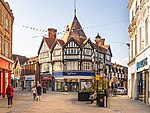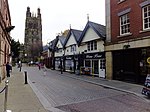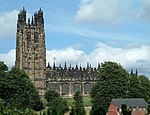Butcher's Market, Wrexham
1848 establishments in WalesBuildings and structures completed in 1848Buildings and structures in WrexhamGrade II listed buildings in Wrexham County BoroughRetail markets in Wales ... and 1 more
Use British English from May 2023

The Butcher's Market (Welsh: Marchnad y Cigyddion) is an indoor market in Wrexham city centre, Wales. It is situated inside a Grade II listed building on Wrexham's High Street. Built in 1848 to the Neo-Jacobean designs of Thomas Penson and extended in 1879–80, it is one of the two dedicated indoor markets of Wrexham. The indoor market has since suffered from declining visitor numbers over the last few years, as a result Wrexham County Borough Council have announced plans to re-develop the indoor market from 2023.
Excerpt from the Wikipedia article Butcher's Market, Wrexham (License: CC BY-SA 3.0, Authors, Images).Butcher's Market, Wrexham
Bank Street, Wrexham City Centre
Geographical coordinates (GPS) Address External links Nearby Places Show on map
Geographical coordinates (GPS)
| Latitude | Longitude |
|---|---|
| N 53.045362 ° | E -2.992291 ° |
Address
Butchers' Market
Bank Street
LL11 1BE Wrexham, City Centre
Wales, United Kingdom
Open on Google Maps










